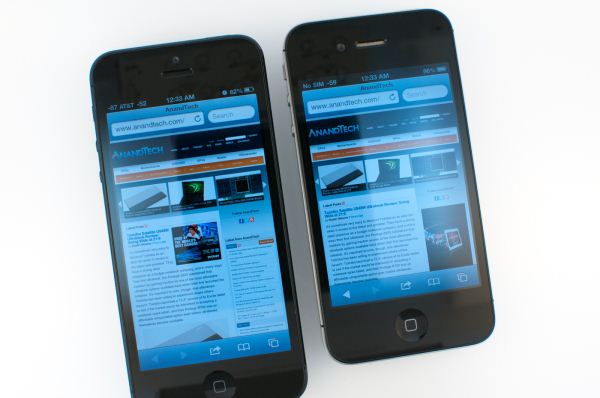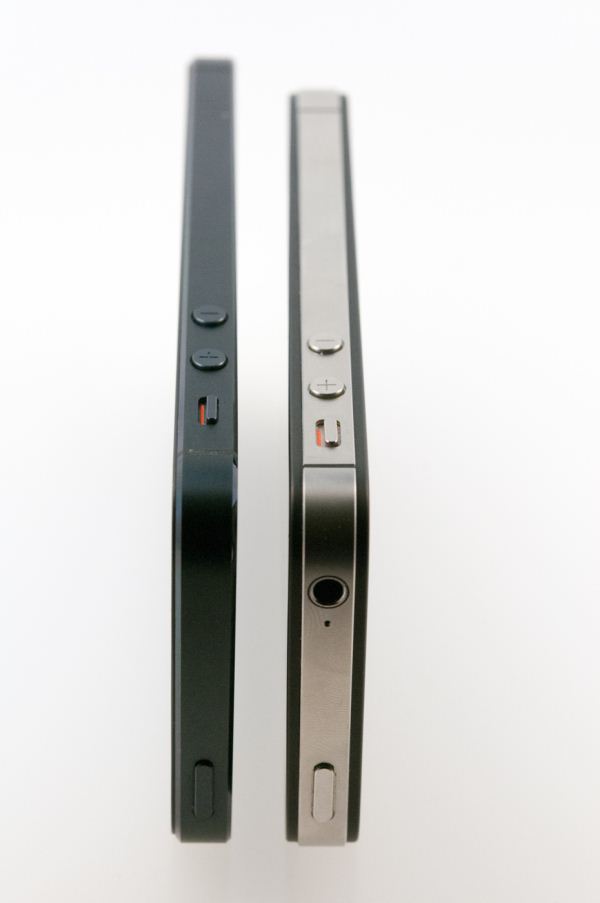The iPhone 5 Review
by Anand Lal Shimpi, Brian Klug & Vivek Gowri on October 16, 2012 11:33 AM EST- Posted in
- Smartphones
- Apple
- Mobile
- iPhone 5
The last significant redesign of the iPhone platform came in 2010 with the iPhone 4. It was an update that literally touched all aspects of the device, from SoC to display to baseband and of course, chassis. Last month’s launch of the iPhone 5 is no different in magnitude. The sixth generation iPhone makes some of the biggest changes to the platform since its introduction in 2007.
Visually the device begins by evolving the design language of the iPhone 4/4S chassis. From the launch of the iPhone 4 it was quite obvious that Apple had picked a design it was quite proud of. Thus it’s not too surprising that, from a distance, the iPhone 5 resembles the previous two iPhone models. We’ll get into material differences shortly, but what make the iPhone 5 design such a radical departure is its larger display.
All previous iPhones have maintained the same 3.5-inch, 3:2 aspect ratio display. With the rest of the world quickly moving to much larger displays, and with 16:9 the clear aspect ratio of choice, when faced with the decision of modernizing the iPhone platform the choice was obvious.
The iPhone 5 embraces a taller, 4-inch, 16:9 1136 x 640 display opting to lengthen the device instead of increasing its area in both dimensions. The result is a device that is distinctly an iPhone, albeit a modern one. The taller display doesn’t do much to make desktop web pages any easier to read as a result of the width staying the same. Those longing for an HTC One X or Galaxy S 3 sized device running iOS are out of luck. Reading emails and typing are both improved though as there’s now more room for lists and the keyboard no longer occupies as much of the display. The taller device can be more awkward to use if you have smaller hands, but the added screen real estate is honestly worth it. Once you get used to the iPhone 5’s display, going back to the older models is tough.
The taller chassis went on a diet as well. The iPhone 5 is now considerably thinner and lighter than its predecessor, which is yet another factor that contributes to it feeling more modern.
Internally the device changes are just as significant, if not more, than those on the outside. The iPhone 5 includes LTE support, which in areas where LTE networks are deployed can be enough reason alone to warrant an upgrade.
The iPhone 5 also includes a brand new SoC from Apple: the A6. For the first time since the introduction of the iPad, Apple has introduced a major branded SoC on an iPhone first. The iPhone 4 used the A4 after it debuted on the iPad, and the 4S picked up the A5 months after the iPad 2 launched with it. The A6 however arrives first on the iPhone 5, and with it comes two of Apple’s first, custom designed CPU cores. We’ve always known Apple as a vertically integrated device and software vendor, but getting into CPU design takes that to a new level.
| Physical Comparison | ||||
| Apple iPhone 4S | Samsung Galaxy S 3 (USA) | HTC One S | Apple iPhone 5 | |
| Height | 115.2 mm (4.5") | 136.6 mm (5.38" ) | 130.9 mm (5.15" ) | 123.8 mm (4.87") |
| Width | 58.6 mm (2.31") | 70.6 mm (2.78") | 65 mm (2.56") | 58.6 mm (2.31") |
| Depth | 9.3 mm ( 0.37") | 8.6 mm (0.34") | 7.8 mm (0.31") | 7.6 mm (0.30") |
| Weight | 140 g (4.9 oz) | 133g (4.7 oz) | 119.5g (4.21 oz) | 112 g (3.95 oz) |
| CPU | Apple A5 @ ~800MHz Dual Core Cortex A9 | 1.5 GHz MSM8960 Dual Core Krait | 1.5 GHz MSM8260A Dual Core Krait | 1.3 GHz Apple A6 (Dual Core Apple Swift) |
| GPU | PowerVR SGX 543MP2 | Adreno 225 | Adreno 225 | PowerVR SGX 543MP3 |
| RAM | 512MB LPDDR2-800 | 2 GB LPDDR2 | 1 GB LPDDR2 | 1 GB LPDDR2 |
| NAND | 16GB, 32GB or 64GB integrated | 16/32 GB NAND with up to 64 GB microSDXC | 16 GB NAND | 16, 32, or 64 GB integrated |
| Camera | 8 MP with LED Flash + Front Facing Camera | 8 MP with LED Flash + 1.9 MP front facing | 8 MP with LED Flash + VGA front facing | 8 MP with LED Flash + 1.2MP front facing |
| Screen | 3.5" 960 x 640 LED backlit LCD | 4.8" 1280x720 HD SAMOLED | 4.3" 960x540 Super AMOLED | 4" 1136 x 640 LED backlit LCD |
| Battery | Internal 5.3 Whr | Removable 7.98 Whr | Removable 6.1 Whr | Internal 5.45 Whr |
There’s a lot to talk about when it comes to the new iPhone. Whether it is understanding the architecture of the A6 SoC or investigating the improved low light performance of the iPhone 5’s rear facing camera, we’ve got it here in what is easily our most in-depth iPhone review to date. Let’s get started.












276 Comments
View All Comments
rarson - Wednesday, October 17, 2012 - link
Car bumpers are not made of aluminum.Aluminum oxidizes. So if you scratch it, then you've removed that oxidation layer to allow it to further oxidize at that spot. Rust is just iron oxidation.
Spunjji - Friday, October 19, 2012 - link
It is not normal for them to scratch so damn easily. Furthermore, you might notice that other manufacturers (say, HTC?) take steps to harden the surfaces of their devices to avoid this kind of problem.name99 - Wednesday, October 17, 2012 - link
So you're basically(a) upset that Apple fans buy products based on how they look
(b) upset that Apple fans's don't care enough about how products look to care about this
???
The true sign of the demented mind --- that it can happily hold two contradictory opinions at once.
steven75 - Wednesday, October 17, 2012 - link
Would you buy a car that gets nicks and scratches from normal usage?Um yes, everyone does. I guess all cars should be recalled!
Spunjji - Friday, October 19, 2012 - link
Would you buy a car that gets nicks and scratches from simply driving down the street? No, you wouldn't. Stop distorting the argument for an easy victory, it makes for extremely aggravating reading.doobydoo - Saturday, October 20, 2012 - link
And what evidence do you have that the equivalent of 'driving down the street' with an iPhone causes scratching?ltcommanderdata - Tuesday, October 16, 2012 - link
Any final MHz rating on the GPU? Given Apple tends to use a 4:1 clock speed ratio between the CPU and GPU, the SGX543MP3 being up to 325MHz would make sense. The SGX543MP2 seemed to be clocked at 200MHz in the iPhone 4S and 250MHz in the iPad 2 and Apple said the iPad 2012 has a 2x faster GPU, so the SGX543MP4 in the A5X likely is also at 250MHz. A SGX543MP3 at 325MHz vs a SGX543MP4 at 250MHz would seem to explain the results seen in the benchmarks.A few corrections, on page 11 the GLBenchmark 2.5 - Triangle Texture Test - Fragment Lit (Offscreen 180p) is missing the iPad 2012 result.
In iPhone 5 Device Conclusions on page 22, you write "Going back to the old 4:3 aspect ratio iPhones feels extremely claustrophobic now", but it should be 3:2.
daar - Tuesday, October 16, 2012 - link
The in-depth tech info was nice, but would have preferred it in a second post. As an engineer, while I can appreciate the advances made with the new SoC and the depth of the effort went into researching all the aspects of the phone, I also think for most purposes, the length is counterproductive when the majority of readers are looking for indicators of whether the phone is worth an upgrade. Even without the tech explanation though, the review unnaturally lacked the concise detail I'm used to at AT.In some ways, it sort of came across that the tech explanation was a long worded way of making excuses for the iPhone 5's faults and direct comparisons to superior implementations were ignored. Simple example would be the camera, where praise was given about how they cut the size, that it looked good, explanation of the purple tint and so forth. If say, Samsung had released a phone with such issues, I'd expect the review to mention the sloppiness of it, esp with rivals such as the One X having a 2.0f lens (I quite enjoyed the One X/SG3 review comparison from AT). The excuse that the lack of innovation in the new iOS being that the aim of the phone is like that of an appliance whereas Android phones aiming to be PC's is baffling; the concept of a smartphone was a versatile device to aid in our daily lives not reach a point of some ambiguity called an appliance.
darwinosx - Tuesday, October 16, 2012 - link
That was a lot of words to say nothing besides bragging that you are an engineer. Nobody cares.kyuu - Tuesday, October 16, 2012 - link
What nobody cares about are your rabid attacks on any comment that has even the slightest critique of an Apple product.